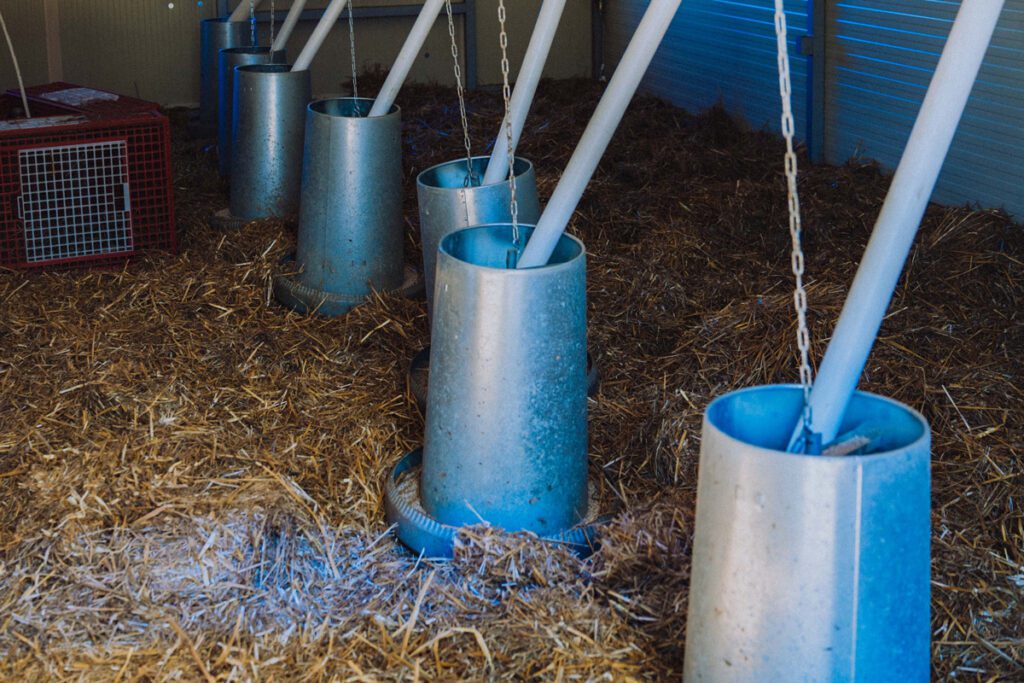There are many references you’re a bit lost and we understand. How to choose the ideal type of feeder for your hens ?
You have a new poultry project or are improving your farm? You can’t afford to overlook one of the most important pieces of equipment for your hens: the feeders. But there are many references, so you feel a bit lost, and we understand. How to choose the ideal feeder for your hens?
Imagine being guided, from a distance, as you make your choice based on the most important criteria, for you and your chickens? Let’s take a tour of the chicken feeder aisle.
Understanding the importance of choosing the right feeder for your hens
It’s no secret that a balanced diet is essential to keep your animals in good health. When rearing broiler chickens, the amount of feed consumed will vary as they grow. For laying hens, around 125 grams of feed a day is needed to produce good eggs.
And while the content is important, you shouldn’t neglect the container. The wrong choice of feeder can affect the performance of your farm if it is not adapted to the needs of your hens.
The different types of feeder
Feeders, the diferent distribution systems
Circular feeders
These feeders are self-sufficient for several days, thanks to the flow of grain that adapts to your hens’ appetite. When the feeder empties, the feed in the reservoir flows out to guarantee continuous availability.
They are generally smaller sizes, and can be suspended to be at the height of the birds. They come in a range of sizes, mainly in small volumes. The hens spread out all around and enjoy the feast to their heart’s content.
They are best suited to smallholdings, as they have limited storage capacity and need to be filled up regularly. They have the advantage of being easily moveable.
Linear feeders
They take up very little space and guarantee easy access for the animals, on either side of the feeder, or on one side only if fixed to the wall. They generally have a larger capacity, so require less frequent handling
Automatic feeders
For the technology-savy, these systems eliminate the distribution stage. They transport the feed from the storage silo and release it at specific times of the day or automatically when a minimum level is reached. The feeders can be adjustable to adapt the feed dosage. This is very practical for managing a feed regime precisely, depending on the growth stage of the broiler chickens in particular. However, this does not mean that you do not need to check the mechanism regularly.
It’s a good system for reducing handling and back pain when you start rearing a larger number of chickens
Feeders, the diferent types of material
Made of plastic or galvanised steel, the different models are more or less suitable for different purposes. We’ll take a look at their characteristics and how this can influence your final choice when buying a hen feeder.
Choosing a feeder for indoor rearing
Specific considerations for indoor feeders
We want as little waste as possible, and we want everyone to be able to have their share. The layout of feeders must therefore allow the animals convenient access. Comfort allows the hens eat calmly and insures they don’t put food aside or that they eat their fill.
Feeders recommented for indoors
Choosing a feeder for outdoor rearing
The challenge of the outdoors
It’s crucial that the feeder is made from materials that can withstand a wide range of weather conditions. Mother nature’s whims can put your equipment to the test and shorten its lifespan, if the quality is not right.
Models recommented for outdoor use
These are often larger than indoor models. For 250kg of feed, for example, you can have just one galvanised metal hopper feeder, instead of 6 to 12 for the same quantity indoors.
It’s best to fit feeders with lids to protect the grain from moisture and avoid attracting predators.
Criteria for selecting a feeder for your hens
Durability and cleaning
Feeders made from galvanised steel or high-quality plastic are preferable. Galvanised steel is more resistant to weather and rust, while high-quality plastic is lighter and easier to clean.
Ease of use cleaning
The right layout is important so that you and the hens can move around easily. It also limits wastage, and that’s a big enough expense as it is, isn’t it?
You’ll also appreciate that you don’t have to spend hours distributing feed or cleaning the feeders. A large number of individual hoppers will take longer to clean than a single linear feeder. And properly cleaned equipment means a healthier environment and avoids the risk of contamination by pathogens.
The number of hens and their age
Candlelit dinner or family banquet? Depending on the number of birds, you won’t need the same amount of space around the feeder or the same storage capacity. It’s also a good idea for larger farms to look into the possibility of automating the feeding system, which can be more cost-effective than manual labour.
As far as volume is concerned, if you have over 10 hens, it’s better to invest in a system with more than 15kg of autonomy.
As you may know, chicks and adult hens have different needs. For chicks, offer tray feeders. This will prevent choking accidents if the greediest chicks rush into feeders that are too big for them.
The size of feeders is regulated for farms with over 350 hens: for a circular feeder, you need 4cm/hen and for a linear feeder, 10cm/hen.

The budget
A feeder designed to last a long time will be more expensive, but the investment is sometimes more profitable. Do the math : you should expect to pay from around €20 for a 20-litre feeder, and from €200 for models weighing more than 100kg, or more than 160 litres (external steel hoppers).
For professional livestock farmers, there are a number of financing options that can reduce the cost.
In any case, don’t hesitate to get in touch with the manufacturers or distributors to get a personalised quote. That’s the best way to get a price that’s precisely tailored to your needs, thanks to the advice of a specialist.
Conclusion
The choice of hen feeders is a key factor in the success and performance of your poultry farm. Making the right choices now means reaping the benefits of your investment later.
Take the time to consider the criteria that are most important to you, and you’re sure to make the right decision!







